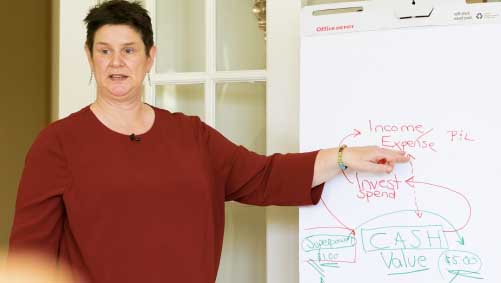
I had an incredible conversation today with another CFO-ey type who is trying to land a new client for his fractional/virtual CFO services business. His prospect is a serial entrepreneur who’s embarking on a business venture based on an absolutely brilliant idea. He explained to the prospect, how his company could lend her a helping hand by providing some financial business modeling.
But here’s the kicker: when he mentioned forecasting to the entrepreneur (which is the obvious CFO-ey thing to suggest here), her response was, “Nah, I just have some goals. We’re good there.”
Let me tell you, this gal had goals that could put an Olympic athlete to shame.
My CFO friend rattled off the specifics this potential client had shared with such precision that I stopped and thought…. this is already a forecast! It’s just well-disguised!
It was an eye-opening moment for me and for my friend, and it reinforced the relentless fact that what I call something and what my clients call exactly the same thing can often be worlds apart.
And here’s why it hit me like a lightning bolt: I’ve set myself a mission to prove to entrepreneurs that finance can (and they deserve it to be) their most engaging best friend instead of the boring or obnoxious kid in the corner. Fast forward a year, and I want those entrepreneurs to shout from the rooftops, “Finance is FUN!” And guess what? They’ll actually mean it.
But if I even dare to think that I can achieve that mission by forcing people to adapt to my fancy financial jargon, well, I’m barking up the wrong tree. It taught me a valuable lesson—I need to serve my audience using the language that resonates with them. So, I listen first and talk second. And then I adapt to their language. Perhaps this is an outcome of being raised for six years in a foreign country. I know what it’s like to not understand the language, and I remember with love the people who made it easier for a newcomer.
The right language will follow – it always does – once they are truly immersed in the immeasurable value of the services you provide. For my clients, it’s when the light bulb goes off and they realize that their finances are their biggest asset and that they really do understand them!
When I step into the role of CFO for an entrepreneur or business owner, my mission is crystal clear: I make it my top priority to ensure they have the information they need, precisely when they need it, and in a format that clicks with them. As they zoom through the daily chaos of their business, my job is to swoop in, align with their momentum, and hand them that vital piece of paper or essential information at exactly the right time, so they can grab it on the fly (like a baton) without missing a beat. And when the time comes to digest it, it needs to make 100% sense in their language.
Recently, after just an hour of reviewing finances with one of my clients, they exclaimed, “That was hands down the most valuable hour I’ve spent on my business ALL MONTH – Thank you thank you thank you!” That right there is the goal, my friend. And you don’t achieve that by speaking your own language, but by speaking your client’s language.
This reminds me of some brilliant advice I received from my mentor: Simplify, simplify, and, then, right when you think you’ve finished simplifying – simplify some more.
At first, I was skeptical, thinking it would insult the intelligence of these brilliant entrepreneurs. But here’s the truth—these business masterminds couldn’t care less about understanding accounting or my fancy lingo. It’s not a knock on their intelligence; it’s actually a testament to your respect for their precious time and their own expertise. That realization hit me like a ton of bricks.
So, here’s of the Pam Prior version of that sage advice:
Break it down into bite-sized pieces. Instead of talking to your clients about the vast concept of your wisdom treasury, break it down to something tangible (like a checking account). Then break it down further into manageable chunks (like deposits in a checking account). And, then, simplify even more it to something very specific (like Stripe transactions).
This isn’t about underestimating the intelligence of your audience—it’s about serving them tiny finance nuggets they can easily digest in the limited time they have for their business finances. And my goal as a CFO is to provide a finance pillar that seamlessly integrates into each business, and resonates with its owner, making them think, “Oh, here’s a report from my financial whiz—no second thoughts needed because it’s worth every precious second I invest.”
And let me tell you, my friend, that’s precisely what you should strive for in all your businesses—for your beloved clients. Simplify, connect, and make it worthwhile – in your client’s language.





